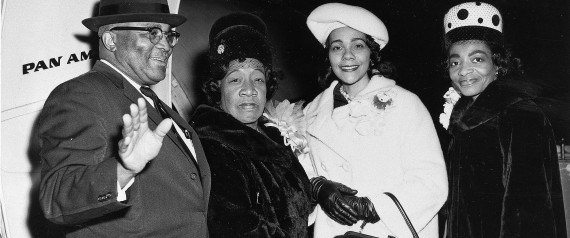“If it is easier for the political establishment to embrace Martin Luther
King’s doctrine than to look into the mirror of the consequences of
racial oppression and justice held up to the world by Malcolm X, the
political reality annoys Ilyasah: “Why can’t these people just have a
backbone and invite Malcolm? I mean, what is the big deal? Put a bust up
of Malcolm X. Let’s tell the truth about Malcolm X,” she says.
Shabazz was there on the afternoon of 21 February
1965 when her father was shot more than 20 times by followers of his
former organisation, the Nation of Islam. She was sitting alongside her
three small sisters, and her mother, who was pregnant with twin girls.
At two and a half years old, Shabazz says she remembers nothing of the
terrifying events of that day, but she does remember something of her
father himself: “I remember a big, tall, beautiful person with these big
teeth. And I remember my doll that he’d given me, and I remember my
rocking chair. I remember his voice.”
What she remembers most about her father is love; something
she knows not often associated with his public representation as an
angry militant separatist. While Malcolm, born El-Hajj Malik El-Shabazz,
advocated discipline, self reliance and pride in the black community
and his African roots, he never supported violence, she says – only
telling his followers that they were entitled to defend themselves in
the face of the horrific assaults and murders that black people faced on
a daily basis. After he left the Nation of Islam in 1964, he embraced
Sunni Islam and evolved his stance on topics as wide ranging as women’s
rights, interracial marriage, and the possibility of people of all races
and colours working together against injustice in a common brotherhood.
At the time of his death he was no longer Malcolm X,
preaching to black urban ghettos, but Malcolm the global revolutionary,
who had brought together an alliance of African and Middle Eastern
leaders in support of his new Organization of Afro-American Unity, and
who was intent on pressing his human rights claims against the US
government at the United Nations.
It was an evolution lost on most of mainstream America,
however, who remembered the man who once said, “The common enemy is the
white man,” reminded black Americans that it was within their legal
rights to buy a shotgun, and said president Kennedy’s assassination was a
case of “chickens coming home to roost”. After his murder, The New York
Times called him an “extraordinary and twisted man” who had turned his
gifts to “evil purpose”, while TIME denounced him a demagogue whose
“creed was violence”.
Malcolm’s image has been tampered with, just as Dr King’s image was
tampered with,” Ilyasah says. Her father needed to use strong language,
she believes, to wake people up to what black Americans faced. “He used
that shock factor,” she says. “It wasn’t that he thought white people
were the devil – not all white people. He had to use these extreme
measures because he was trying to uplift people. And so he educated a
mis-educated people – and by that I mean all of America.”
Read the full article by Karen Bartlett on
Newsweek.






.jpg)

 increase our understanding of where we stand in the larger global picture. How would our lives change if we could witness
increase our understanding of where we stand in the larger global picture. How would our lives change if we could witness